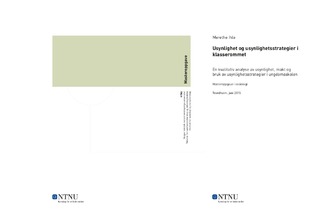| dc.description.abstract | Masteravhandlingen undersøker hvorfor elever blir usynlige i klasserommet og hvilke
strategier de tar i bruk for å oppnå denne usynligheten. Usynlighetsfenomenet i skolen er
undersøkt gjennom åtte observasjonsøkter og tre gruppeintervjuer av elever i niende klasse.
Basert på datamaterialet avdekkes det fire hovedtyper for usynlighetsstrategier: (i) usynlighet
gjennom aktivitet, (ii) usynlighet gjennom kropp, (iii) usynlighet gjennom klær og (iv)
usynlighet gjennom synlighet. Ved å anvende Michel Foucault og hans begreper om
disiplineringsmakt og overvåkingssamfunn vises det hvordan usynlighet i klasserommet må
forstås på bakgrunn av sosiale prosesser og maktstrukturer som eksisterer i klasserommet.
Datamaterialet, i samspill med Foucaults teoretisk perspektiv, gir blant annet grunnlag for å
anta at de ulike usynlighetsstrategiene og usynligheten disse frembringer må forstås som
motstrategier mot ulike maktteknikker utøvd i skolen. Dette gjelder særlig det sanksjonerende
og straffende aspektet ved den disiplinære makten utøvet av lærere og medelever i
klasserommet. Resultatene er likevel ikke helt entydige da det også kan se ut til at elever blir
usynlige som resultat av disiplinering. Tolkninger av datamaterialet gir videre grunnlag for å
hevde at den type usynlighet frembrakt av disiplineringen er nødvendig for å kunne iverksette
usynlighet og usynlighetsstrategier som motstrategier mot maktteknikkene. Avhandlingen
understreker et behov for mer forskning på usynlighet blant elever i klasserommet og kommer
med forslag til videre forskningsmuligheter.
This master's thesis investigates why some students become invisible in the classroom, and
what strategies they use to achieve this invisibility. The phenomenon of invisibility in school
has been investigated through eight sessions of observation in a classroom, as well as three
group interviews with students in the ninth grade. Based on the collected data, four strategies
for invisibility are revealed: (i) invisibility through activity, (ii) invisibility through body, (iii)
invisibility through clothing and (iv) invisibility through visibility. By using Michael
Foucalt's terms of disciplinary power and surveillance society, the thesis shows how
invisibility in the classroom must be understood in light of the social processes and power
structures that exist within the classroom. The collected data, in concert with the theoretical
perspective of Foucault, suggests that the various strategies of invisibility and the invisibility
they provide must be understood as counter-strategies to the various techniques of power
exercised in school. In particular, this regards the sanctioning and punishing aspect of the
disciplinary power wielded by teachers and fellow students in the classroom. However, these
results are not entirely unambiguous, as it also seems that some students become invisible as a
result of disciplinary actions. Interpretations of the collected data further suggests that such
discipline-caused invisibility is necessary for engaging the invisibility and invisibility
techniques used as counter-strategies to the techniques of power. The thesis emphasizes the
need for more research on student invisibility, and provides suggestions for further studies. | nb_NO |
